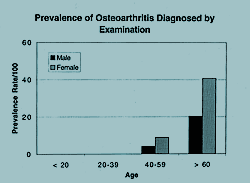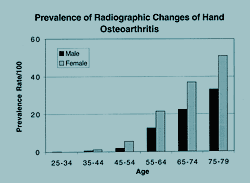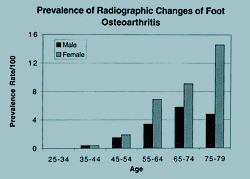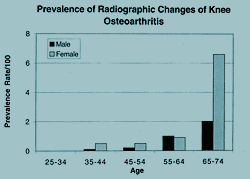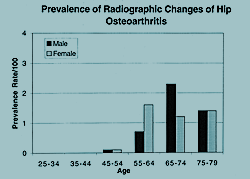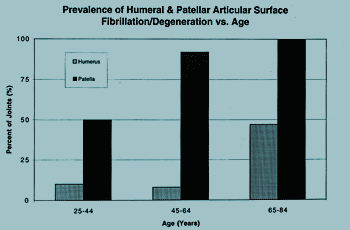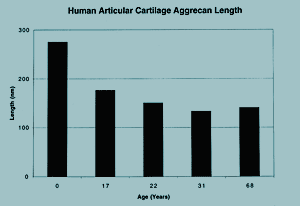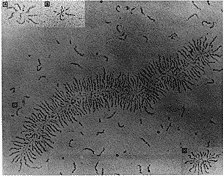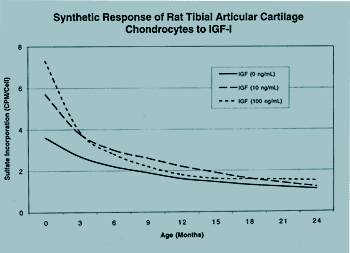|
Osteoarthritis
In contrast
to the aging changes in articular cartilage, osteoarthritis is a clinical
syndrome due to the degeneration of synovial joints. One of the first
events in articular cartilage degeneration is disruption or alteration
of the molecular structure and composition of the matrix. Some of the
early matrix changes in articular cartilage degeneration include loss
of proteoglycans and an increase in water concentration. The tissue damage
stimulates a chondrocytic synthetic and proliferative response that may
maintain or even restore the articular cartilage. This chondrocytic response
may continue for years; however, in progressive joint degeneration, eventually
the chondrocytic anabolic response declines and the imbalance between
chondrocyte synthetic activity and degradative activity leads to progressive
thinning and loss of articular cartilage. Even in the early stages of
the joint degeneration the stiffness of the articular cartilage declines
and its permeability increases. These alterations in material properties
may further accelerate the progression of the disease. The response of
the synovial joint to joint degeneration can in some instances restore
a form of cartilaginous surface. It is not clear how frequently this occurs,
but well documented studies of small groups of patients confirm that even
in individuals with complete loss of articular cartilage the potential
exists for spontaneous restoration of a cartilaginous surface that may
function effectively for years. Thus far the characteristics of patients
in whom this response occurs have not been defined, but this phenomenon
deserves further study.
If articular
cartilage aging and osteoarthritis are distinct processes (Table 1), how
can the striking increase in the prevalence of the joint degeneration
responsible for osteoarthritis with age be explained? The answer appears
to be that the structural, molecular, cellular and mechanical changes
that occur in articular cartilage with age increase the vulnerability
of the tissue to degeneration. Furthermore, the evidence that articular
cartilage chondrocytes are less responsive to anabolic cytokines with
increasing age suggests that older articular cartilage is less able to
repair and restore itself. Thus, the aging of articular cartilage does
not cause osteoarthritis, but the aging changes in articular cartilage
increase the risk of joint degeneration, and decrease the ability of joint
tissues to prevent progression once degeneration begins.
|
|
Effects
of Aging on the Results of Methods of Restoring Articular Cartilage
Understanding
of the aging of articular cartilage and its relationship to osteoarthritis
has significant implications for strategies intended to restore cartilaginous
articular surfaces. Currently, these strategies can be separated into
two groups: those performed with the intention of stimulating articular
cartilage repair or regeneration, and those that include transplantation
of osteochondral autografts or allografts. The outcomes of both strategies
may be significantly influenced by the changes that occur in articular
cartilage with aging.
Current
clinical procedures intended to promote articular cartilage repair and
regeneration include penetration of subchondral bone, altering joint loading
by osteotomies or joint distraction and use of perichondrial and periosteal
transplants. Experimental methods promoting formation of cartilaginous
articular surfaces include use of artificial matrices, chondrogenesis
factors and cell transplants. Penetration of subchondral bone by a variety
of methods including abrasion, drilling and penetration with a sharp awl
or pick (a procedure referred to as microfracture) stimulates formation
of a fibrin clot followed by invasion of the fibrin clot by undifferentiated
cells that proliferate, differentiate into chondrocyte like cells and
synthesize a matrix that contains high concentrations of many of the molecules
found in normal articular cartilage including type II collagen and aggregating
proteoglycans. The chondral repair tissue that forms following these procedures
is less stiff and more permeable than normal articular cartilage. This
may make the tissue more vulnerable to degeneration although some patients
do develop excellent symptomatic relief. Because of the limitations of
the chondral tissue formed following penetration of subchondral bone,
some surgeons perform autograft transplants of perichondrium and periosteum
with the intent of generating a new articular surface. The available evidence
suggests that both penetration of subchondral bone and periosteal and
perichondrial transplants are less clinically successful in middle aged
and older people than in adolescents and young adults. There is less experience
with autograft cell transplantation, use of artificial matrices and chondrogenesis
factors, but given the reliance of these procedures on host cells it is
reasonable to expect that they will less successful in older individuals
than in young adults. Use of fetal cell allograft transplants offers the
potential of overcoming some of the limitations of relying on host cells
from older patients, but the efficacy of this approach has not yet been
demonstrated.
A variety
of methods of performing osteochondral allografts and autografts have
been developed to replace damaged or degenerated articular surfaces. The
experience of Allan Gross in Toronto and others with osteochondral allografts
suggests that when these transplants are performed in young adults to
replace focal defects in otherwise normal joints they can successfully
provide pain relief and improve joint function for more than 60% of the
patients for as long as 20 years. A number of surgeons have also been
transplanting osteochondral autografts from a region of normal articular
to regions of damaged articular cartilage. Although the effects of patient
age on the results of both allografts and autografts have not been extensively
studied, the available information suggests that both procedures are less
successful in middle-aged and older people.
Conclusions
Articular
cartilage undergoes age-related changes that increase the risk of the
joint degeneration that causes the clinical syndrome of osteoarthritis.
In addition, these changes adversely affect the outcomes of attempts to
repair or regenerate articular cartilage. Perhaps the most important of
these age changes involve alterations in chondrocyte synthesis of proteoglycans
and in the responsiveness of chondrocytes to anabolic factors. Is it possible
to slow, or temporarily reverse at least some of the age-related changes
in articular cartilage that increase the probability of joint degeneration?
Once degenerative changes have developed, can they be stabilized or reversed?
Will it be possible to develop methods that predictably produce functional,
durable cartilagenous articular surfaces for middle age and older people
with joint injuries and joint degeneration? Further study will definitively
answer these questions. However, the investigation of articular cartilage
aging is only beginning and the observations developed thus far strongly
suggest that better understanding of the aging changes in articular cartilage
and how these changes influence the ability of the tissue to maintain
and regenerate itself will lead to improved methods of preserving and
restoring articular surfaces for middle-aged and older individuals.
|

